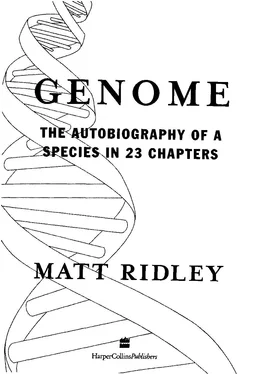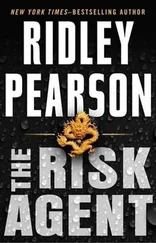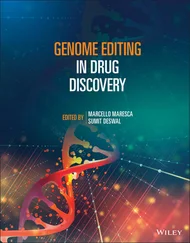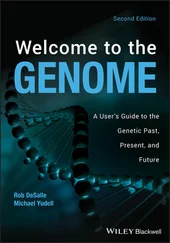Genome - Matt Ridley
Здесь есть возможность читать онлайн «Genome - Matt Ridley» — ознакомительный отрывок электронной книги совершенно бесплатно, а после прочтения отрывка купить полную версию. В некоторых случаях можно слушать аудио, скачать через торрент в формате fb2 и присутствует краткое содержание. Жанр: Старинная литература, на английском языке. Описание произведения, (предисловие) а так же отзывы посетителей доступны на портале библиотеки ЛибКат.
- Название:Matt Ridley
- Автор:
- Жанр:
- Год:неизвестен
- ISBN:нет данных
- Рейтинг книги:5 / 5. Голосов: 1
-
Избранное:Добавить в избранное
- Отзывы:
-
Ваша оценка:
- 100
- 1
- 2
- 3
- 4
- 5
Matt Ridley: краткое содержание, описание и аннотация
Предлагаем к чтению аннотацию, описание, краткое содержание или предисловие (зависит от того, что написал сам автор книги «Matt Ridley»). Если вы не нашли необходимую информацию о книге — напишите в комментариях, мы постараемся отыскать её.
Matt Ridley — читать онлайн ознакомительный отрывок
Ниже представлен текст книги, разбитый по страницам. Система сохранения места последней прочитанной страницы, позволяет с удобством читать онлайн бесплатно книгу «Matt Ridley», без необходимости каждый раз заново искать на чём Вы остановились. Поставьте закладку, и сможете в любой момент перейти на страницу, на которой закончили чтение.
Интервал:
Закладка:
In practice, though, it is more likely that Mme Calment could thank other genes for her longevity. Long telomeres are no good if the body decays rapidly; the telomeres will soon be shortened by the need for cell division to repair damaged tissues. In Werner's syndrome, an inherited misfortune characterised by premature and early ageing, the telomeres do indeed get shorter much more rapidly than in other people, but they start out the same size. The reason they get shorter is probably that the body lacks the capability to repair properly the corrosive damage done by so-called free radicals
- atoms with unpaired electrons created by oxygen reactions in the body. Free oxygen is dangerous stuff, as any rusty piece of iron can testify. Our bodies, too, are continually 'rusting' from the effects of oxygen. Most of the mutations that cause 'longevity', at least in flies and worms, turn out to be in genes that inhibit the production of free radicals - i.e., they prevent the damage being done in the first place, rather than prolong the replicating life of cells that repair the damage. One gene, in nematode worms, has enabled scientists to breed a strain that lives to such an exceptional age that they would be 350 years old if they were human beings. In fruit flies, Michael 2 0 4 G E N O M E
Rose has been selecting for longevity for twenty-two years: that is, in each generation he breeds from the flies that live the longest. His
'Methuselah' flies now live for 120 days, or twice as long as wild fruit flies, and start breeding at an age when wild fruit flies usually die. They show no sign of reaching a limit. A study of French centenarians quickly turned up three different versions of a gene on chromosome 6 that seemed to characterise long-lived people.
Intriguingly, one of them was common in long-lived men and another was common in long-lived women.10
Ageing is turning out to be one of those things that is under the control of many genes. One expert estimates that there are 7,000
age-influencing genes in the human genome, or ten per cent of the total. This makes it absurd to speak of any gene as 'an ageing gene'
let alone ''the ageing gene'. Ageing is the more or less simultaneous deterioration of many different bodily systems; genes that determine the function of any of these systems can cause ageing, and there is good evolutionary logic in it. Almost any human gene can accumulate with impunity mutations which cause deterioration after breeding age.n
It is no accident that the immortal cell lines used by scientists in the laboratory are derived from cancer patients. The most famous of them, the HeLa cell line, originated in the cervical tumour of a patient named Henrietta Lacks, a black woman who died in Balti-more in 1951. Her cancer cells are so wildly proliferative when cultured in the laboratory that they often invade other laboratory samples and take over the Petri dish. They even somehow reached Russia in 1972 where they fooled scientists into thinking they had found new cancer viruses. HeLa cells were used for developing polio vaccines and have gone into space. Worldwide, they now weigh more than 400 times Henrietta's own body weight. They are spectacularly immortal. Yet nobody, at any time, thought to ask Henrietta Lacks's permission or that of her family - who were hurt when they learnt of her cellular immortality. In belated recognition of a 'scientific heroine', the city of Atlanta now recognises 11 October as Henrietta Lacks Day.
I M M O R T A L I T Y 2 0 5
HeLa cells plainly have excellent telomerase. If antisense R N A is added to HeLa cells - that is, R N A containing the exact opposite message to the R N A message in telomerase, so that it will stick to the telomerase R N A - then the effect is to block the telomerase and prevent it working. The HeLa cells are then no longer immortal.
They senesce and die after about twenty-five cell divisions.12
Cancer requires active telomerase. A tumour is invigorated with the biochemical elixir of youth and immortality. Yet cancer is the quintessential disease of ageing. Cancer rates rise steadily with age, more rapidly in some species than others, but still they rise: there is no creature on earth that is less likely to get cancer in old age than in youth. The prime risk factor for cancer is age. Environmental risk factors, such as cigarette smoking, work in part because they accelerate the ageing process: they damage the lungs, which require repair and repair uses up telomere length, thus making the cells
'older' in telomere terms than they would otherwise be. Tissues that are especially prone to cancer tend to be tissues that do a lot of cell division throughout life either for repair or for other reasons: skin, testis, breast, colon, stomach, white blood cells.
So we have a paradox. Shortened telomeres mean higher cancer risk, but telomerase, which keeps telomeres long, is necessary for a tumour. The resolution lies in the fact that the switching on of telomerase is one of the essential mutations that must occur if a cancer is to turn malignant. It is now fairly obvious why Geron's cloning of the telomerase gene caused its share price to rocket on the hopes of a general cure for cancer. Defeating telomerase would condemn tumours to suffer from the rapid advance of old age themselves.
C H R O M O S O M E 1 5
S e x
All women become like their mothers. That is their tragedy. No man does. That's his.
Oscar Wilde, The Importance of Being Earnest In the Prado Museum in Madrid hangs a pair of paintings by the seventeenth-century court painter Juan Carreno de Miranda, called
'La Monstrua vestida' and 'La Monstrua desnuda': the monster clothed and the monster naked. They show a grossly fat but very unmonstrous five-year-old girl called Eugenia Martinez Vallejo.
There is indeed clearly something wrong with her: she is obese, enormous for her age, has tiny hands and feet and strange-shaped eyes and mouth. She was probably exhibited as a freak at a circus.
With hindsight, it is plain that she shows all the classic signs of a rare inherited disease called Prader-Willi syndrome, in which children are born floppy and pale-skinned, refuse to suck at the breast but later eat till they almost burst, never apparently experiencing satiety, and so become obese. In one case, the parent of a Prader-Willi child found the child had consumed a pound of raw bacon in the back of a car while being driven back from the shop. People with this S E X 2 0 7
syndrome have small hands and feet, underdeveloped sex organs and they are also mildly mentally retarded. At times they throw spectacular temper tantrums, especially when refused food, but they also show what one doctor calls 'exceptional proficiency with jigsaw puzzles'.
Prader-Willi syndrome was first identified by Swiss doctors in 1956. It might have been just another rare genetic disease, of the kind I have repeatedly promised not to write about in this book because G E N E S A R E N O T T H E R E T O C A U S E D I S -
E A S E S . But there is something very odd about this particular gene.
In the 1980s doctors noticed that Prader-Willi syndrome sometimes occurs in the same families as a completely different, disease, a disease so different it might almost be called the opposite of Prader-Willi: Angelman's syndrome.
Harry Angelman was a doctor working in Warrington in Lanca-shire when he first realised that rare cases of what he called 'puppet children' were suffering from an inherited disease. In contrast to those with Prader-Willi syndrome, they are not floppy, but taut.
They are thin, hyperactive, insomniac, small-headed and long-jawed, and often stick out their large tongues. They move jerkily, like puppets, but have a happy disposition; they are perpetually smiling and are given to frequent paroxysms of laughter. But they never learn to speak and are severely mentally retarded. Angelman children are much rarer than Prader-Willi children, but they sometimes crop up in the same family tree.2
Читать дальшеИнтервал:
Закладка:
Похожие книги на «Matt Ridley»
Представляем Вашему вниманию похожие книги на «Matt Ridley» списком для выбора. Мы отобрали схожую по названию и смыслу литературу в надежде предоставить читателям больше вариантов отыскать новые, интересные, ещё непрочитанные произведения.
Обсуждение, отзывы о книге «Matt Ridley» и просто собственные мнения читателей. Оставьте ваши комментарии, напишите, что Вы думаете о произведении, его смысле или главных героях. Укажите что конкретно понравилось, а что нет, и почему Вы так считаете.












